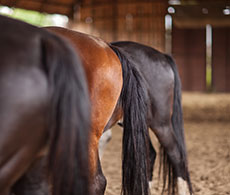
The lowdown on locking stifles
Locking stifles is surprisingly common, and if it affects your horse it can look alarming. But what causes the condition, and are there any treatments available? Petplan Equine vet Gil Riley unlocks the key facts
What is a locking stifle and how does it affect the joint?
-
The stifle is the area where the tibia (the bone that forms your horse’s gaskin) meets the femur (the bone that extends up to his hip) and it can be compared to our own knees – when you pick up a horse’s hind leg, the joint bends forwards, just as your knee does when you walk up stairs.
As horses evolved, they underwent various physical changes designed to help them survive. One especially clever adaptation is a locking mechanism in the stifle, which allows your horse to keep standing while sleeping – all with minimal muscular effort.
But this mechanism can also cause trouble. When the ligament involved doesn’t unlock spontaneously, or if it locks at the wrong time, it gives rise to a locking stifle. (Or, to give it its proper veterinary name, ‘upward fixation of the patella’.)
What are the causes and which horses are most at risk?
-
The exact cause of locking stifles isn’t known, but it’s thought it could be due to conformation factors such as straight limbs and a weakness of the quadriceps muscles (those found near the top of your horse’s hind legs).
It’s most often seen in young horses that are growing rapidly. In these cases, the growth of your horse’s bones may slightly exceed his muscular growth. This can change the angles of his joints, and even small variations could affect the smooth functioning of the stifle.
It is also common in horses in poor condition, or those that have dropped off suddenly. When muscle tone is lost, the ligament around the stifle slackens, leaving it more prone to catching on the femur bone and ‘locking’.
How can you spot the initial signs and what should you do?
-
A locked stifle is very obvious and can look alarming. However, it’s usually not as serious as it first appears. If your horse has the condition, he’ll stand with his hind leg locked in extension (it will appear very straight and stiff) and he may drag the toe of his hoof along the floor behind him. Usually, the leg will unlock of its own accord, but some horses may need assistance. Asking your horse to rein back will allow the ligament to slacken and, as it does so, unlock the joint.
How can you tell the difference between a locking stifle and other conditions affecting the hind legs, such as stringhalt?
-
Stringhalt is a neurological disease, which causes uncontrollable exaggerated movement. It’s quite different from a locking stifle, as a horse with stringhalt will typically jerk its hind legs up high and pause before taking the next step.
I’ve found that owners more commonly mistake a locking stifle for a broken leg. But it’s important to remember that, unlike a broken leg or other significant injury, a locking stifle will rarely cause your horse any distress. If your horse does become stuck in extension, but is otherwise happy and has no visible wounds, a locking stifle is the likely culprit. If you’re at all worried, though, it’s always best to call your vet.
How can I manage the problem?
-
If your horse is young and prone to the condition, it shouldn’t be a cause for concern: the majority of young horses will simply grow out of it as their muscles develop fully. However, in older or poorly developed horses, if the stifle locks regularly and movement is hampered as a result, intervention may be necessary.
This can be done with a targeted exercise programme or, if the condition is severely affecting your horse’s quality of life, with surgery (see more on this below). Walking and trotting up hills, and work on varied surfaces to encourage the hindquarters to get pumping, will all aid in building the muscles in your horse’s hind end. This will help to increase the tension of the necessary ligament around the stifle, and will stop it from catching.
There are also various supplements available (such as those that are rich in a muscular protein called creatine) that your vet might recommend to help improve muscle condition.
When is surgery necessary, and what are the options?
-
If an exercise programme or supplements don’t seem to be working for your horse, and the condition is affecting his welfare, your vet will then consider surgery.
Traditionally, surgery to treat locking stifles involved cutting through the ligament in that area (called the medial patella ligament) to prevent it catching. However, this is a relatively risky procedure for your horse to undergo.
More modern techniques can be carried out under local anaesthetic, and these can significantly reduce the risk to your horse. One method involves injecting iodine directly into the ligament to cause it to stiffen (and prevent any slackening), which makes it less likely to catch on the femur. Another method is to initiate a small amount of direct trauma to the area (either with a laser, or by surgically creating a small flesh wound), which then causes scar tissue to form and reduces the elasticity of the ligament.
In both cases, your vet will recommend the best – and safest – course of action after assessing your horse’s condition and needs.



